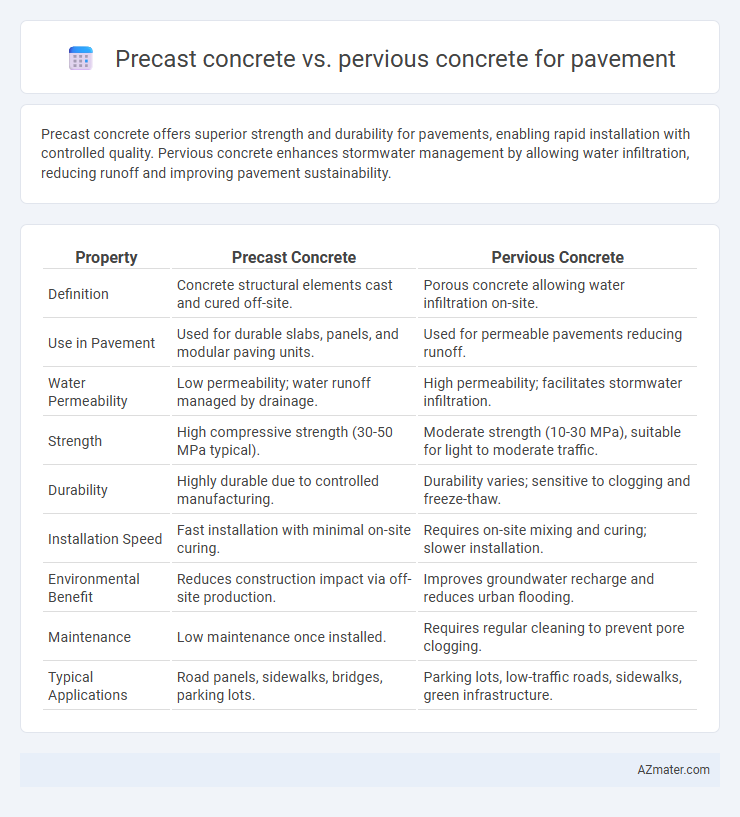Precast concrete offers superior strength and durability for pavements, enabling rapid installation with controlled quality. Pervious concrete enhances stormwater management by allowing water infiltration, reducing runoff and improving pavement sustainability.
Table of Comparison
| Property | Precast Concrete | Pervious Concrete |
|---|---|---|
| Definition | Concrete structural elements cast and cured off-site. | Porous concrete allowing water infiltration on-site. |
| Use in Pavement | Used for durable slabs, panels, and modular paving units. | Used for permeable pavements reducing runoff. |
| Water Permeability | Low permeability; water runoff managed by drainage. | High permeability; facilitates stormwater infiltration. |
| Strength | High compressive strength (30-50 MPa typical). | Moderate strength (10-30 MPa), suitable for light to moderate traffic. |
| Durability | Highly durable due to controlled manufacturing. | Durability varies; sensitive to clogging and freeze-thaw. |
| Installation Speed | Fast installation with minimal on-site curing. | Requires on-site mixing and curing; slower installation. |
| Environmental Benefit | Reduces construction impact via off-site production. | Improves groundwater recharge and reduces urban flooding. |
| Maintenance | Low maintenance once installed. | Requires regular cleaning to prevent pore clogging. |
| Typical Applications | Road panels, sidewalks, bridges, parking lots. | Parking lots, low-traffic roads, sidewalks, green infrastructure. |
Overview of Precast and Pervious Concrete
Precast concrete consists of factory-made concrete components that are cast and cured in controlled environments, ensuring high strength and durability for pavement applications. Pervious concrete is designed with a high void content to allow water infiltration, reducing runoff and improving stormwater management on pavements. Both materials offer unique advantages, with precast concrete providing rapid installation and structural reliability, while pervious concrete enhances environmental sustainability and groundwater recharge.
Material Composition and Properties
Precast concrete used in pavement typically consists of a dense mixture of cement, aggregates, and admixtures, resulting in high compressive strength and durability suitable for heavy traffic loads. Pervious concrete features a porous matrix composed of cement, coarse aggregates, and minimal fine aggregates, allowing water to infiltrate and reduce runoff while maintaining adequate structural integrity. The key material properties differ as precast concrete emphasizes strength and uniformity, whereas pervious concrete prioritizes permeability and environmental benefits.
Manufacturing and Installation Processes
Precast concrete for pavement is manufactured in controlled factory environments, ensuring consistent quality and faster curing times before transportation to the installation site, which allows for rapid assembly and reduced on-site labor. Pervious concrete is mixed and poured directly on-site, requiring careful water and material control during installation to maintain its porous structure for effective stormwater infiltration. The precast approach minimizes weather dependency and installation time, while pervious concrete demands precise handling during on-site placement to preserve permeability and structural integrity.
Environmental Impact and Sustainability
Precast concrete pavement reduces construction waste through factory-controlled production and offers enhanced durability, minimizing resource consumption over its lifespan. Pervious concrete promotes groundwater recharge and reduces stormwater runoff, mitigating urban flooding and improving water quality. Both materials contribute to sustainability, with precast concrete emphasizing resource efficiency and longevity, while pervious concrete enhances environmental permeability and ecosystem health.
Durability and Longevity Comparison
Precast concrete offers superior durability for pavement applications due to its controlled manufacturing environment, resulting in consistent strength and reduced permeability that withstands heavy traffic and freeze-thaw cycles. Pervious concrete enhances stormwater management by allowing water infiltration but tends to have lower compressive strength and higher susceptibility to clogging and wear, which can reduce its longevity in high-traffic areas. Choosing between precast and pervious concrete for pavement depends on balancing the need for long-term structural integrity with environmental benefits like improved drainage.
Load-Bearing Capacity for Pavements
Precast concrete pavements exhibit higher load-bearing capacity due to their controlled manufacturing environment, which ensures consistent strength and durability, making them suitable for heavy traffic areas. Pervious concrete, designed for enhanced drainage, generally has lower compressive strength and load-bearing capacity compared to precast options, limiting its use to light or moderate traffic applications. Engineers often select precast concrete when structural performance under heavy loads is a critical design criterion for pavement projects.
Maintenance and Repair Requirements
Precast concrete pavement offers lower maintenance needs due to its controlled manufacturing process, ensuring uniform strength and durability, which reduces the frequency of repairs. Pervious concrete requires more regular maintenance such as vacuuming or pressure washing to prevent clogging of its porous structure, essential for sustaining its drainage capabilities. Repairing precast concrete typically involves replacing entire panels, whereas pervious concrete patches can be more localized but may compromise permeability if not properly executed.
Cost Analysis and Lifecycle Costs
Precast concrete offers lower initial construction costs due to controlled factory production and faster installation, while pervious concrete generally incurs higher upfront expenses because of specialized materials and installation techniques. Lifecycle costs favor pervious concrete by reducing stormwater management expenses, minimizing pavement deterioration through improved drainage, and lowering maintenance needs over time. Evaluating total cost of ownership highlights precast concrete's short-term savings versus pervious concrete's long-term economic and environmental benefits in pavement applications.
Applications and Suitability for Different Projects
Precast concrete offers high strength and durability, making it ideal for heavy-traffic pavements, highways, and industrial areas requiring rapid installation and minimal on-site curing. Pervious concrete enhances stormwater management in parking lots, residential roads, and pedestrian pathways by allowing water infiltration, significantly reducing runoff and improving groundwater recharge. Selecting between these materials depends on project requirements: precast concrete suits high-load and fast-track projects, while pervious concrete is optimal for sustainable designs prioritizing permeability and environmental impact.
Choosing the Right Concrete for Your Pavement
Choosing the right concrete for pavement depends on factors such as drainage needs and load-bearing requirements. Precast concrete offers superior strength and durability for heavy traffic areas, providing quick installation and consistent quality. Pervious concrete enhances stormwater management by allowing water to infiltrate the surface, reducing runoff and promoting environmental sustainability.

Infographic: Precast concrete vs Pervious concrete for Pavement
 azmater.com
azmater.com